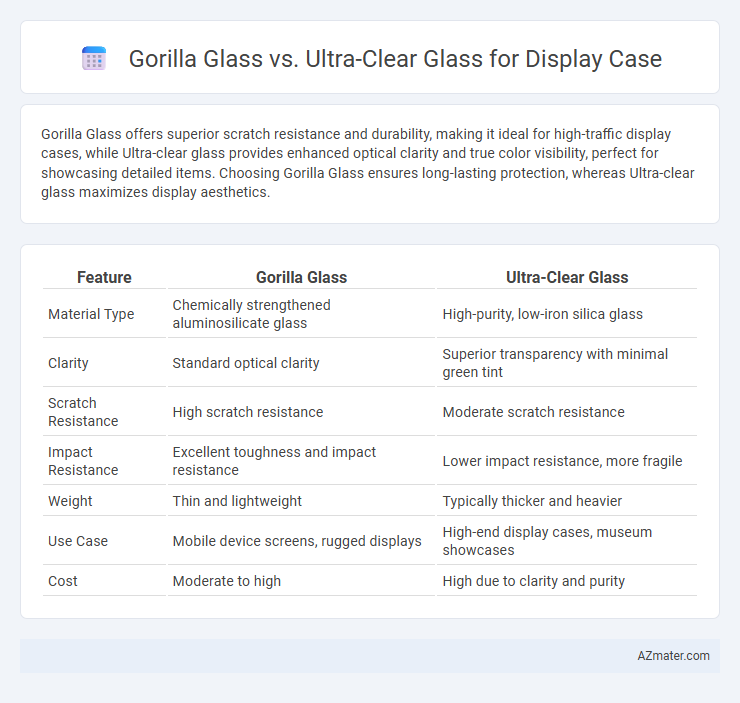Gorilla Glass offers superior scratch resistance and durability, making it ideal for high-traffic display cases, while Ultra-clear glass provides enhanced optical clarity and true color visibility, perfect for showcasing detailed items. Choosing Gorilla Glass ensures long-lasting protection, whereas Ultra-clear glass maximizes display aesthetics.
Table of Comparison
| Feature | Gorilla Glass | Ultra-Clear Glass |
|---|---|---|
| Material Type | Chemically strengthened aluminosilicate glass | High-purity, low-iron silica glass |
| Clarity | Standard optical clarity | Superior transparency with minimal green tint |
| Scratch Resistance | High scratch resistance | Moderate scratch resistance |
| Impact Resistance | Excellent toughness and impact resistance | Lower impact resistance, more fragile |
| Weight | Thin and lightweight | Typically thicker and heavier |
| Use Case | Mobile device screens, rugged displays | High-end display cases, museum showcases |
| Cost | Moderate to high | High due to clarity and purity |
Introduction to Display Case Glass Options
Display case glass options primarily include Gorilla Glass and Ultra-clear Glass, each offering distinct benefits for protection and visibility. Gorilla Glass is known for its exceptional scratch resistance and durability, making it ideal for high-traffic environments where impact resistance is crucial. Ultra-clear Glass provides superior optical clarity and minimal color distortion, enhancing the display's visual appeal and ensuring true-to-life color representation.
What is Gorilla Glass?
Gorilla Glass is a chemically strengthened, alkali-aluminosilicate sheet glass designed for high durability and scratch resistance in electronic displays. It undergoes a special ion-exchange process that increases its surface compression, making it highly resistant to impacts and drops compared to conventional ultra-clear glass. This combination of toughness and optical clarity makes Gorilla Glass a preferred choice for display cases in smartphones, tablets, and other portable devices.
What is Ultra-clear Glass?
Ultra-clear glass is a high-transparency glass with low iron content, designed to provide maximum light transmission and minimal color distortion, making it ideal for display cases that require true color representation and optimal visibility. Gorilla Glass, by contrast, is chemically strengthened for enhanced durability and scratch resistance but may have slightly lower clarity compared to ultra-clear glass. For display cases where visual clarity and accurate color rendering are critical, ultra-clear glass outperforms standard Gorilla Glass by offering superior transparency and a more vivid viewing experience.
Key Differences: Gorilla Glass vs Ultra-clear Glass
Gorilla Glass offers superior scratch resistance and impact durability, making it ideal for high-traffic display cases exposed to frequent handling. Ultra-clear glass provides enhanced transparency and minimal color distortion, ensuring optimal product visibility for showcase environments prioritizing aesthetics. The choice between Gorilla Glass and Ultra-clear glass depends on whether impact resistance or clarity is the primary requirement for display case applications.
Durability and Strength Comparison
Gorilla Glass offers superior durability with its chemically strengthened composition, making it highly resistant to scratches and impacts commonly encountered in display cases. Ultra-clear glass prioritizes transparency and optical clarity but generally lacks the enhanced scratch and impact resistance found in Gorilla Glass. When comparing strength, Gorilla Glass provides a tougher and more resilient surface, ideal for protecting valuable items in high-traffic environments.
Clarity and Visual Performance
Gorilla Glass offers enhanced scratch resistance and durability while maintaining high clarity, making it ideal for displays requiring long-lasting visual performance. Ultra-clear glass excels in transparency with minimal light distortion, providing superior color accuracy and brightness for premium visual experiences. Both glasses optimize display clarity, but Ultra-clear glass typically delivers crisper image quality due to its reduced green tint and higher light transmittance.
Scratch Resistance and Surface Hardness
Gorilla Glass provides superior scratch resistance and surface hardness compared to ultra-clear glass, making it ideal for high-impact and heavy-use display cases. Its chemically strengthened layer achieves a Mohs hardness rating of around 7, significantly reducing the likelihood of visible scratches and abrasions during daily use. Ultra-clear glass, while offering exceptional clarity and minimal color distortion, generally has lower hardness levels, making it more prone to scratching under abrasive conditions.
Cost Analysis: Gorilla Glass vs Ultra-clear Glass
Gorilla Glass typically incurs higher upfront costs due to its chemically strengthened properties and scratch resistance, making it a premium choice for high-durability display cases. Ultra-clear glass offers a more affordable option with excellent optical clarity but may require additional protective treatments to match Gorilla Glass's durability, potentially increasing long-term expenses. When evaluating total cost of ownership, Gorilla Glass can provide better value by reducing maintenance and replacement frequency compared to ultra-clear glass in high-traffic environments.
Ideal Use Cases for Each Glass Type
Gorilla Glass offers superior scratch resistance and durability, making it ideal for high-traffic retail displays and electronic devices requiring robust protection. Ultra-clear glass provides exceptional transparency and color accuracy, perfect for showcasing fine jewelry or delicate collectibles where visual clarity is paramount. Selecting Gorilla Glass ensures long-lasting strength in rugged environments, while Ultra-clear glass enhances visual appeal in settings demanding pristine optical quality.
Choosing the Right Glass for Your Display Case
Gorilla Glass offers superior scratch resistance and durability, making it ideal for high-traffic or outdoor display cases where protection against impact is crucial. Ultra-clear glass provides exceptional transparency and minimal color distortion, perfect for showcasing items with true-to-life clarity in indoor display cases. Selecting the right glass depends on balancing durability needs with the visual presentation requirements of your display environment.

Infographic: Gorilla glass vs Ultra-clear glass for Display case
 azmater.com
azmater.com